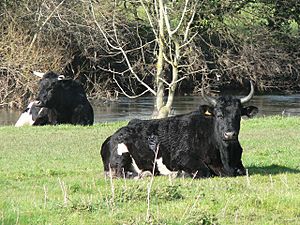Shetland cattle facts for kids

Shetland cattle in a pasture
|
|
| Country of origin | Scotland |
|---|---|
| Distribution | Britain, Ireland and Australia |
| Use | Beef, dairy and (historically) draft |
| Traits | |
| Weight |
|
| Coat | White spots upon black, fine haired |
| Horn status | Horned |
|
|
Shetland cattle, also called Shetland kye in the Scots language, are a small and tough breed of cattle. They come from the Shetland Islands in northern Scotland. These cattle are usually black and white. But you can also find some in grey, red, or dun colours.
Contents
What Makes Shetland Cattle Special?
Shetland cattle are often black and white, much like the Holstein Friesian breed. About 10% of them are red and white. A small but growing number are dun (a dull brownish-grey) and grey.
Size and Appearance
Shetland cows are smaller than most other cattle. They usually weigh from 350 kg to 450 kg (770 to 990 lb). The bulls are heavier, weighing between 550 kg and 600 kg (1,210 to 1,320 lb). Breeders consider them to be a small-sized cattle breed. Their horns curve upwards.
Winter Coat and Good Traits
During winter, Shetland cattle grow a long, hairy coat. This coat helps keep them warm. They shed this thick hair when summer arrives. Many farmers like Shetland cattle because they are easy to calve (give birth). Their calves also grow quickly to adult size.
A Look Back at Shetland Cattle History
Shetland cattle have been around for a very long time! People on the Shetland Islands started raising them way back around 3,600 BC. This was during the Stone Age.
Early Ancestors
The first cattle on the islands were very large. They were probably young aurochs, which were wild cattle. Aurochs used to roam across Europe and Asia. Bones found in old Shetland settlements show that these early cattle were tamed.
Becoming Smaller Over Time
Over many years, the cattle on the islands became smaller. By the Bronze Age (around 2,500 BC), both large and small cattle were present. By the Iron Age (about 2,000 years ago), only the smaller type remained. This smaller animal was just over one meter tall at the shoulder. It was described as a "short-legged, stocky, short-horned beast."
Hard Times for Farmers
In the early 1800s, the number of Shetland cattle dropped a lot. This was because landowners made farms smaller. They wanted more people to work in fishing. This was a very hard time for the people and their animals on Shetland. The Shetland cow helped many families survive these difficult years. Only a tough breed could handle such harsh conditions.
Challenges and Revival Efforts
In the 19th century, new, heavier breeds of cattle came to Britain. This was not good for native breeds like the Shetland kye. In the early 1900s, people started to appreciate Shetland cattle more. The Shetland Cattle Herd Book Society was formed in 1912. It kept a record of the breed's features and registered calves and bulls.
After the Second World War, the government offered money to farmers. But these payments did not apply to Shetland kye. This made farmers choose larger breeds that grew faster. Many native cows were cross-bred with bigger animals. This almost made the Shetland kye disappear.
Saving the Breed
By the time oil was found near Shetland, the breed was almost gone. People like T. A. U. Fraser, known as Tammy o da Glebe, helped save them. He started with just four cows in 1938. In the 1980s, he helped bring the breed back.
In 1981, a big effort was made to save the breed again. The New Foundation Herd Book and Shetland Cattle Herd Book Society (SCHBS) was started. For a while, the Shetland Islands Council helped support purebred calves. Today, volunteers are working hard to protect the breed's future.
Helping Other Islands
During the Falklands War, five pregnant Shetland cows and one bull were sent to the Falkland Islands. They replaced livestock that had been lost in the conflict. This was a big surprise because the breed was so rare. At that time, only 121 adult cows were registered. Sending them was seen as a way to help increase their numbers.
Healthy Traits
The Shetland Cattle Herd Book Society has worked to record the special traits of the breed. Studies show that the meat and milk from Shetland cattle are very healthy. They contain more good minerals and fatty acids than modern breeds.
Shetland Cattle Today
Today, Shetland cattle are used to produce beef for special markets. These cattle are often kept on smaller farms. These farms earn good money from sales and have low costs for feeding the animals. A very small number of people in Shetland still keep these cattle for their own needs.
Currently, there are about 800 registered breeding cows. Around 180 calves are born each year.
Protecting the Future
Efforts to restore the Shetland breed are still ongoing. The Shetland Cattle Herd Book Society continues to protect the breed. They now have a database and a semen store. This helps preserve important genetics and makes them available to members. The Shetland Cattle Breeder's Association also helps breeders in mainland UK. They offer advice on genetics, breeding, and finding other breeders.

